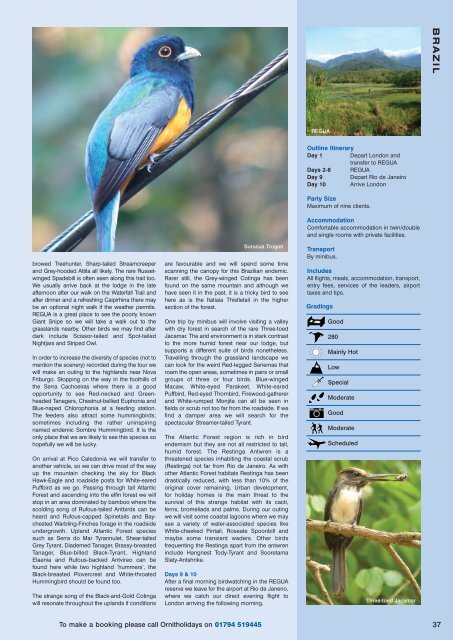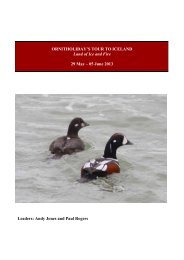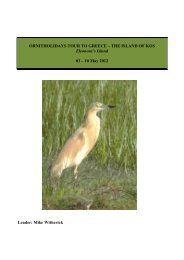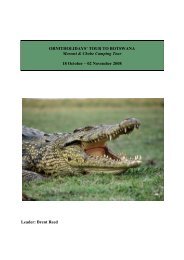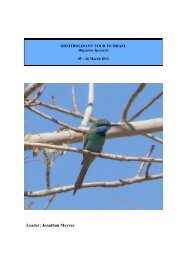Download 2014 Brochure (.pdf) - Ornitholidays
Download 2014 Brochure (.pdf) - Ornitholidays
Download 2014 Brochure (.pdf) - Ornitholidays
You also want an ePaper? Increase the reach of your titles
YUMPU automatically turns print PDFs into web optimized ePapers that Google loves.
B R A Z I L<br />
REGUA<br />
browed Treehunter, Sharp-tailed Streamcreeper<br />
and Grey-hooded Attila all likely. The rare Russetwinged<br />
Spadebill is often seen along this trail too.<br />
We usually arrive back at the lodge in the late<br />
afternoon after our walk on the Waterfall Trail and<br />
after dinner and a refreshing Caipirhina there may<br />
be an optional night walk if the weather permits.<br />
REGUA is a great place to see the poorly known<br />
Giant Snipe so we will take a walk out to the<br />
grasslands nearby. Other birds we may find after<br />
dark include Scissor-tailed and Spot-tailed<br />
Nightjars and Striped Owl.<br />
In order to increase the diversity of species (not to<br />
mention the scenery) recorded during the tour we<br />
will make an outing to the highlands near Nova<br />
Friburgo. Stopping on the way in the foothills of<br />
the Serra Cachoeiras where there is a good<br />
opportunity to see Red-necked and Greenheaded<br />
Tanagers, Chestnut-bellied Euphonia and<br />
Blue-naped Chlorophonia at a feeding station.<br />
The feeders also attract some hummingbirds;<br />
sometimes including the rather uninspiring<br />
named endemic Sombre Hummingbird. It is the<br />
only place that we are likely to see this species so<br />
hopefully we will be lucky.<br />
On arrival at Pico Caledonia we will transfer to<br />
another vehicle, so we can drive most of the way<br />
up the mountain checking the sky for Black<br />
Hawk-Eagle and roadside posts for White-eared<br />
Puffbird as we go. Passing through tall Atlantic<br />
Forest and ascending into the elfin forest we will<br />
stop in an area dominated by bamboo where the<br />
scolding song of Rufous-tailed Antbirds can be<br />
heard and Rufous-capped Spinetails and Baychested<br />
Warbling-Finches forage in the roadside<br />
undergrowth. Upland Atlantic Forest species<br />
such as Serra do Mar Tyrannulet, Shear-tailed<br />
Grey Tyrant, Diademed Tanager, Brassy-breasted<br />
Tanager, Blue-billed Black-Tyrant, Highland<br />
Elaenia and Rufous-backed Antvireo can be<br />
found here while two highland ‘hummers’, the<br />
Black-breasted Plovercrest and White-throated<br />
Hummingbird should be found too.<br />
The strange song of the Black-and-Gold Cotinga<br />
will resonate throughout the uplands if conditions<br />
Surucua Trogon<br />
are favourable and we will spend some time<br />
scanning the canopy for this Brazilian endemic.<br />
Rarer still, the Grey-winged Cotinga has been<br />
found on the same mountain and although we<br />
have seen it in the past, it is a tricky bird to see<br />
here as is the Itatiaia Thistletail in the higher<br />
section of the forest.<br />
One trip by minibus will involve visiting a valley<br />
with dry forest in search of the rare Three-toed<br />
Jacamar. The arid environment is in stark contrast<br />
to the more humid forest near our lodge, but<br />
supports a different suite of birds nonetheless.<br />
Travelling through the grassland landscape we<br />
can look for the weird Red-legged Seriemas that<br />
roam the open areas, sometimes in pairs or small<br />
groups of three or four birds. Blue-winged<br />
Macaw, White-eyed Parakeet, White-eared<br />
Puffbird, Red-eyed Thornbird, Firewood-gatherer<br />
and White-rumped Monjita can all be seen in<br />
fields or scrub not too far from the roadside. If we<br />
find a damper area we will search for the<br />
spectacular Streamer-tailed Tyrant.<br />
The Atlantic Forest region is rich in bird<br />
endemism but they are not all restricted to tall,<br />
humid forest. The Restinga Antwren is a<br />
threatened species inhabiting the coastal scrub<br />
(Restinga) not far from Rio de Janeiro. As with<br />
other Atlantic Forest habitats Restinga has been<br />
drastically reduced, with less than 10% of the<br />
original cover remaining. Urban development,<br />
for holiday homes is the main threat to the<br />
survival of this strange habitat with its cacti,<br />
ferns, bromeliads and palms. During our outing<br />
we will visit some coastal lagoons where we may<br />
see a variety of water-associated species like<br />
White-cheeked Pintail, Roseate Spoonbill and<br />
maybe some transient waders. Other birds<br />
frequenting the Restinga apart from the antwren<br />
include Hangnest Tody-Tyrant and Sooretama<br />
Slaty-Antshrike.<br />
Days 9 & 10<br />
After a final morning birdwatching in the REGUA<br />
reserve we leave for the airport at Rio de Janerio,<br />
where we catch our direct evening flight to<br />
London arriving the following morning.<br />
Outline Itinerary<br />
Day 1 Depart London and<br />
transfer to REGUA<br />
Days 2-8 REGUA<br />
Day 9 Depart Rio de Janeiro<br />
Day 10 Arrive London<br />
Party Size<br />
Maximum of nine clients.<br />
Accommodation<br />
Comfortable accommodation in twin/double<br />
and single rooms with private facilities.<br />
Transport<br />
By minibus.<br />
Includes<br />
All flights, meals, accommodation, transport,<br />
entry fees, services of the leaders, airport<br />
taxes and tips.<br />
Gradings<br />
Good<br />
280<br />
Mainly Hot<br />
Low<br />
Special<br />
Moderate<br />
Good<br />
Moderate<br />
Scheduled<br />
Three-toed Jacamar<br />
To make a booking please call <strong>Ornitholidays</strong> on 01794 519445<br />
37


